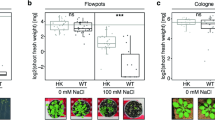Abstract
RESULTS of experiments with scab disease on MM 109 apple rootstock shoots showed a marked lack of reproducibility, even when done in a glasshouse with some control of light and humidity as well as temperature (the mean visible light intensity was controlled to 1,300 ± 200 cal per cm2 per month1, ambient temperatures to 20 ± 2° C during the day and 15 ± 2° C at night with corresponding relative humidities of 70% ± 5% minimum and 90% ± 5% maximum). The disease system seemed to be very susceptible to residual fluctuations in the environment. Although this situation could be partly attributed to mechanical failures, examination of results and sunlight radiation records collected over a period of years indicated that erratic and short reductions in sunlight intensity, due to small cumulus clouds passing during the end of the first week after infection, could account for a considerable part of the irregularity. This study, though stimulated by previous observations on apple scab disease, was done with Venturia inaequalis and Padosphaera leucotricha on MM 109 apple rootstock shoots, and strawberry latent ring-spot virus on cucumber plants, in order to investigate the influence of interrupted light on plant disease generally.
This is a preview of subscription content, access via your institution
Access options
Subscribe to this journal
Receive 51 print issues and online access
$199.00 per year
only $3.90 per issue
Buy this article
- Purchase on Springer Link
- Instant access to full article PDF
Prices may be subject to local taxes which are calculated during checkout
Similar content being viewed by others
References
Hignett, R. C., Lab. Practice, 21, 433 (1972). (Erratum: substitute 12 V, 1.5 W zener diode for photodiode.)
Kirby, A. H. M., and Frick, E. L., Ann. appl. Biol., 51, 61 (1963).
Kirkham, D. S., J. gen. Microbiol., 16, 360 (1957).
Kirkham, D. S., and Hignett, R. C., Third Long Ashton Symp. 1971 (edit. by Byrde, R. J. W., and Cutting, C. V.), 55 (Academic, London, 1973).
Kirkham, D. S., and Hignett, R. C., Nature, 225, 388 (1970).
Smith, M. A., and Kennedy, B. W., Phytopathology, 60, 723 (1970).
Olsson, R., Physiol. Pl., 27, 9 (1972).
Sackston, W. E., and Sheppard, J. W., Can. J. Bot., 51, 23 (1973).
Jackson, D. I., and Field, R. J., Ann. Bot., 36, 525 (1972).
Smith, D. R., and Langhans, R. W., Bull. 194, New York State Flower Growers Inc. (1962).
Author information
Authors and Affiliations
Rights and permissions
About this article
Cite this article
KIRKHAM, D., HIGNETT, R. & ORMEROD, P. Effects of Interrupted Light on Plant Disease. Nature 247, 158–160 (1974). https://doi.org/10.1038/247158a0
Received:
Issue Date:
DOI: https://doi.org/10.1038/247158a0
This article is cited by
Comments
By submitting a comment you agree to abide by our Terms and Community Guidelines. If you find something abusive or that does not comply with our terms or guidelines please flag it as inappropriate.



